Page 251 of 385
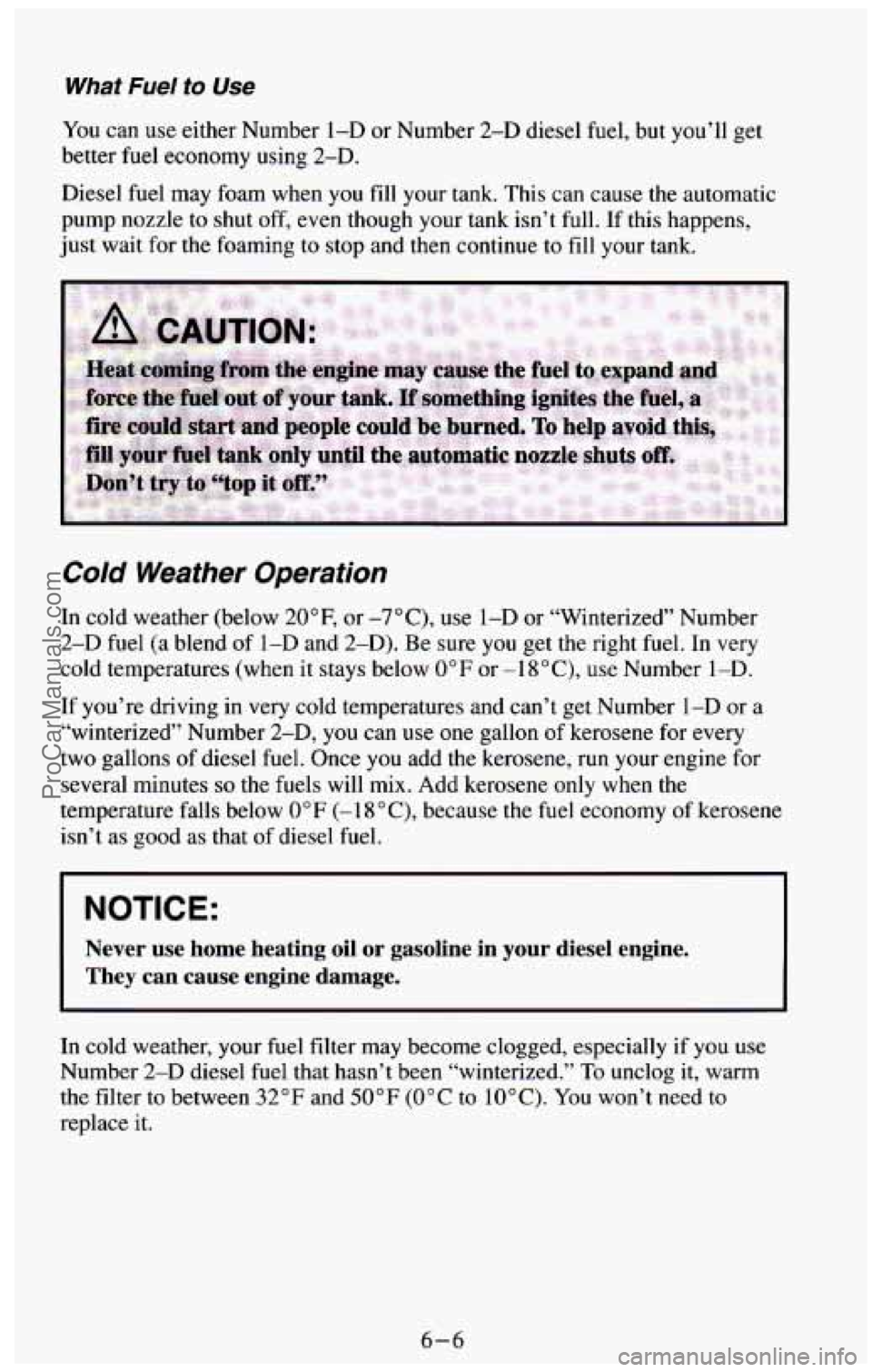
What Fuel to Use
You can use either Number 1-D or Number 2-D diesel fuel, but you’ll get
better fuel economy using
2-D.
Diesel fuel may foam when you fill your tank. This can cause the automatic
pump nozzle to shut
off, even though your tank isn’t full. If this happens,
just wait
for the foaming to stop and then continue to fill your tank.
Cold Weather Operation
In cold weather (below 20”F, or -7”C), use 1-D or “Winterized” Number
2-D fuel (a blend of 1-D and 2-D). Be sure you get the right fuel. In very
cold temperatures (when it stays below
0°F or -18”C), use Number 1-D.
If you’re driving in very cold temperatures and can’t get Number 1-D or a
“winterized” Number
2-D, you can use one gallon of kerosene for every
two gallons of diesel fuel. Once you add the kerosene, run your engine for
several minutes
so the fuels will mix. Add kerosene only when the
temperature falls below
0°F (-1 8 “C), because the fuel economy of kerosene
isn’t as good
as that of diesel fuel.
NOTICE:
Never use home heating oil or gasoline in your diesel engine.
They can cause engine damage.
In cold weather, your fuel filter may become clogged, especially if you use
Number 2-D diesel fuel that hasn’t been “winterized.” To unclog it, warm
the filter to between
32°F and 50°F (0°C to 10°C). You won’t need to
replace it.
6-6
ProCarManuals.com
Page 252 of 385
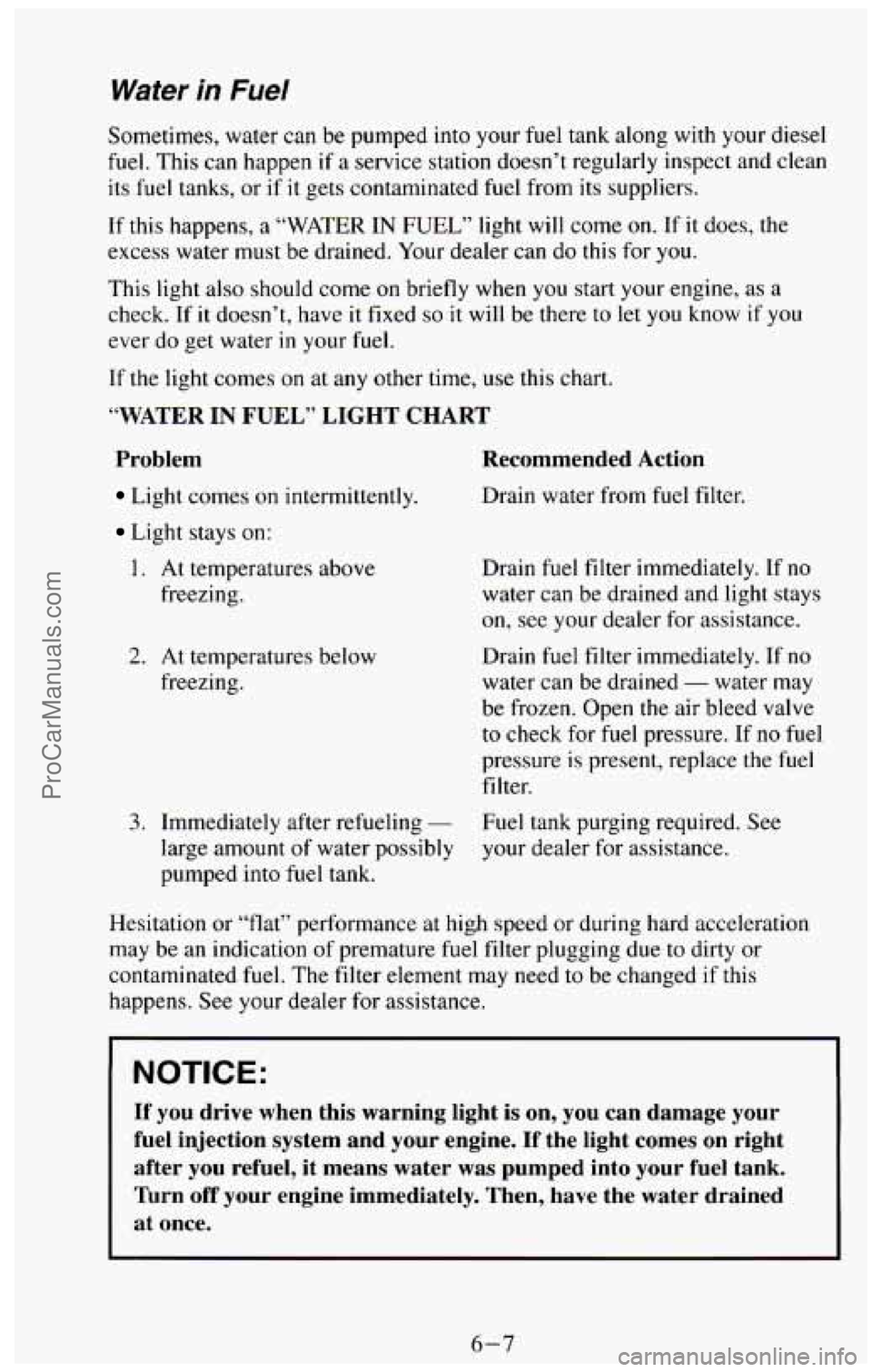
Water in Fuel
Sometimes, water can be pumped into your fuel tank along with your diesel
fuel. This can happen if a service station doesn’t regularly inspect and clean
its fuel tanks, or if it gets contaminated fuel from its suppliers.
If this happens, a “WATER IN FUEL” light will come on. If it does, the
excess water
must be drained. Your dealer can do this for you.
This light
also should come on briefly when you start your engine, as a
check. If it doesn’t, have it fixed so it will be there to let you know if you
ever do get water
in your fuel.
If the light comes on at any other time, use this chart.
“WATER IN FUEL” LIGHT CHART
Problem
Light comes on intermittently.
Light stays on:
1. At temperatures above
freezing.
2. At temperatures below
freezing.
Recommended Action
Drain water from fuel filter.
Drain fuel filter immediately.
If no
water can be drained and light stays
on, see your dealer for assistance.
Drain fuel filter immediately. If no
water can be drained
- water may
be frozen. Open
the air bleed valve
to check for
fuel pressure. If no fuel
pressure
is present, replace the fuel
fi 1 ter.
3. Immediately after refueling - Fuel tank purging required. See
large amount
of water possibly your dealer for assistance.
pumped into fuel tank.
Hesitation or “flat” performance at
high speed or during hard acceleration
may be an indication of premature fuel filter plugging due to dirty or
contaminated
fuel. The filter element may need to be changed if this
happens. See your dealer for assistance.
If you drive when this warning light is on, you can damage your
fuel injection system and your engine.
If the light comes on right
after you refuel,
it means water was pumped into your fuel tank.
Turn
off your engine immediately. Then, have the water drained
at once.
6-7
ProCarManuals.com
Page 253 of 385
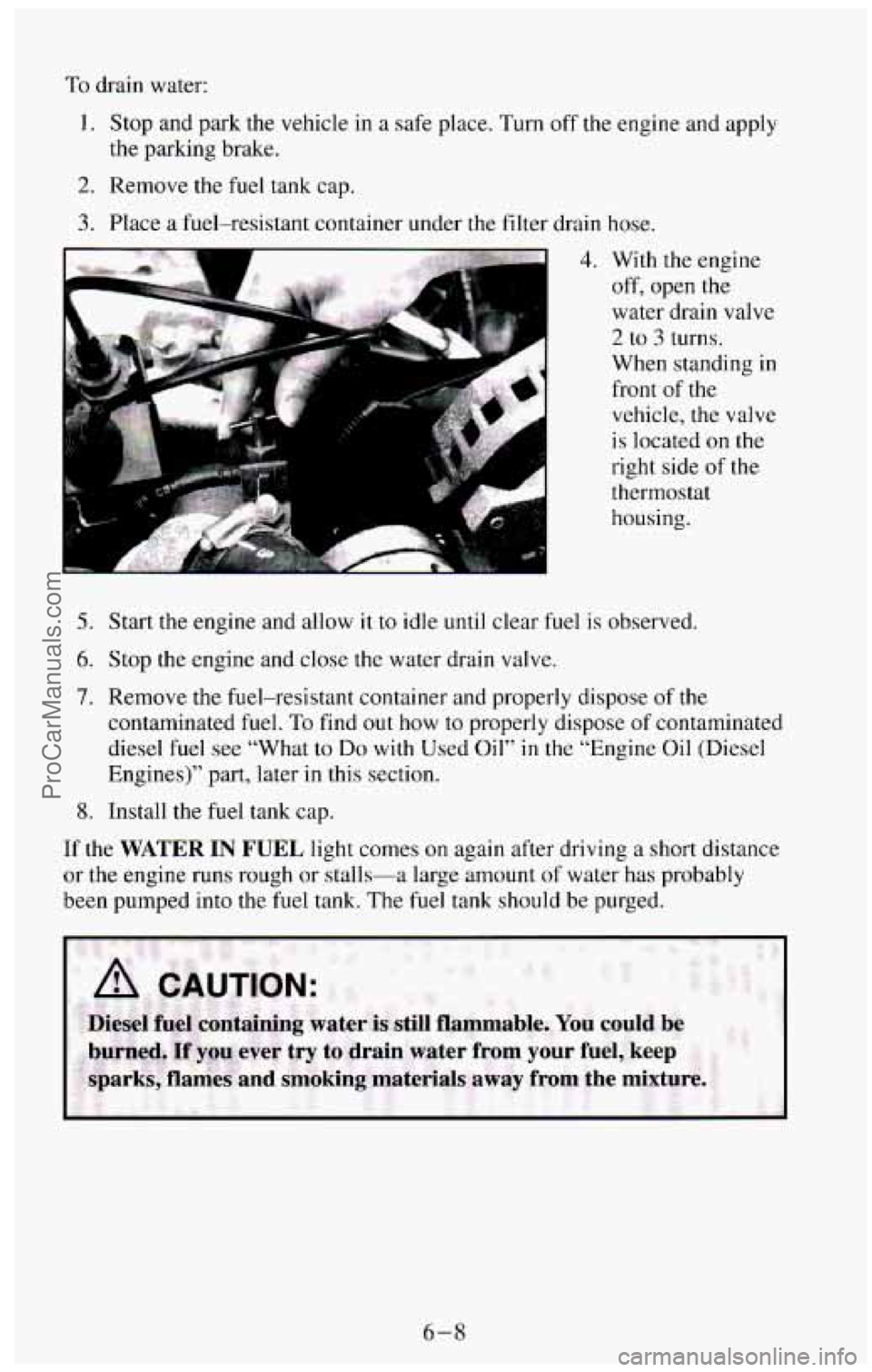
To drain water:
1. Stop and park the vehicle in a safe place. Turn off the engine and apply
2. Remove the fuel tank cap.
the parking brake.
3. Place a
fuel-resistant container under the filter
drain hose.
4. With the engine
off, open the
water drain valve
2 to 3 turns.
When standing in
front of the
vehicle,
the valve
is located
on the
right side
of the
thermostat housing.
5. Start the engine and allow it to idle until clear fuel is observed.
6. Stop the engine and close the water drain valve.
7. Remove the fuel-resistant container and properly dispose of the
contaminated fuel. To find out how
to properly dispose of contaminated
diesel
fuel see “What to Do with Used Oil” in the “Engine Oil (Diesel
Engines)” part, later in
this section.
8. Install the fuel tank cap.
If the
WATER IN FUEL light comes on again after driving a short distance
or the engine
runs rough or stalls-a large amount of water has probably
been pumped into the fuel tank. The fuel tank should be purged.
6-8
ProCarManuals.com
Page 254 of 385
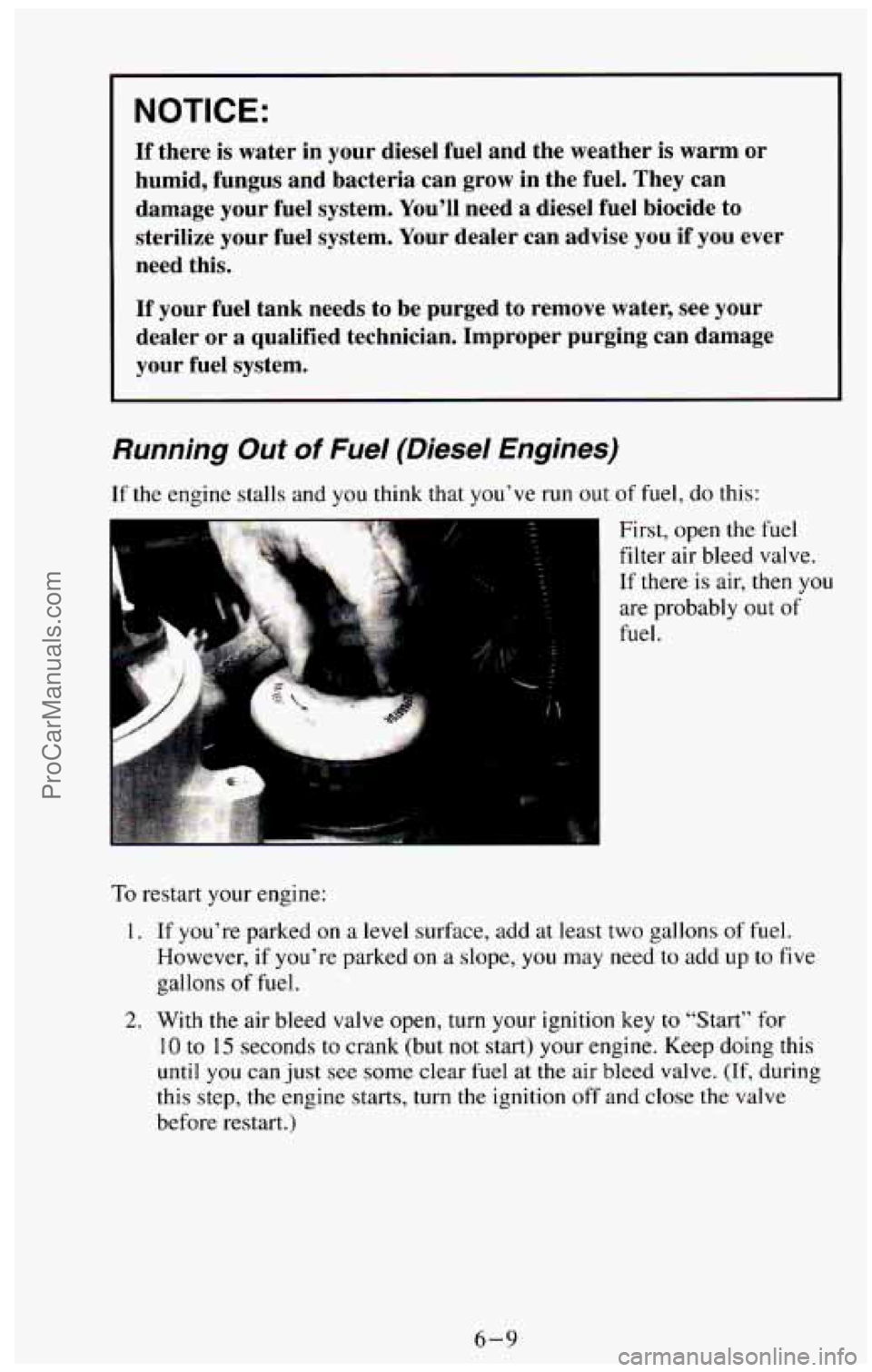
NOTICE:
If there is water in your diesel fuel and the weather is warm or
humid, fungus and bacteria can grow in the fuel. They can
damage your fuel system. You’ll need a diesel fuel biocide
to
sterilize your fuel system. Your dealer can advise you if you ever
need this.
If your fuel tank needs to be purged to remove water, see your
dealer or
a qualified technician. Improper purging can damage
your fuel system.
Running Out of Fuel (Diesel Engines)
If the engine stalls and you think that you’ve run out of fuel, do this:
First, open the fuel
filter air bleed valve.
If there is air, then
you
are probably out of
fuel.
To restart your engine:
1. If you’re parked on a level surface, add at least two gallons of fuel.
However, if you’re parked
on a slope, you may need to add up to five
gallons
of fuel.
10 to 15 seconds to crank (but not start) your engine. Keep doing this
until
you can just see some clear fuel at the air bleed valve. (If, during
this step, the engine starts, turn the ignition off and close the valve
before restart.)
2. With the air bleed valve open, turn your ignition key to “Start” for
6-9
ProCarManuals.com
Page 255 of 385
3. Close the air bleed valve.
4. Turn the ignition key to “Start” for 10 to 15 seconas at a time until your
engine starts.
Fuel Filter Replacement (Diesel Engines)
If you want to change the fuel filter yourself, here’s how to do it:
Drain fuel from the filter by opening the air bleed valve and the water drain
valve. This prevents the
fuel from spilling as you replace the filter. Drain the
fuel into a fuel-resistant container and dispose
of it properly.
1. Turn off the engine and apply the parking brake.
2. Take off the fuel tank cap. This releases vacuum in the tank.
3. The filter is located at the rear of the intake manifold.
4;: .
4. Unscrew and
remove the ring
nut from the top
of the filter head.
6- 10
ProCarManuals.com
Page 256 of 385
8.
9.
10.
5. Lift the element out of the filter
head.
6. If there is any dirt
on the element
sealing surface of
the filter head,
clean it off.
7. Line up the
writing
on the top
of the filter
so it
faces (is readable
from) the front of
the vehicle.
Push
the element in
until the mating
surfaces touch.
With the air bleed valve open, turn your ignition key to
RUN for 10 to
15 seconds. Wait one minute for your starter to cool.
Do this until you
can see clear fuel coming from the air bleed valve.
Close the air bleed valve and replace the fuel cap.
Start your engine and let it idle for five minutes. Check your fuel filter
and air bleed valve for leaks.
6-11
ProCarManuals.com
Page 267 of 385
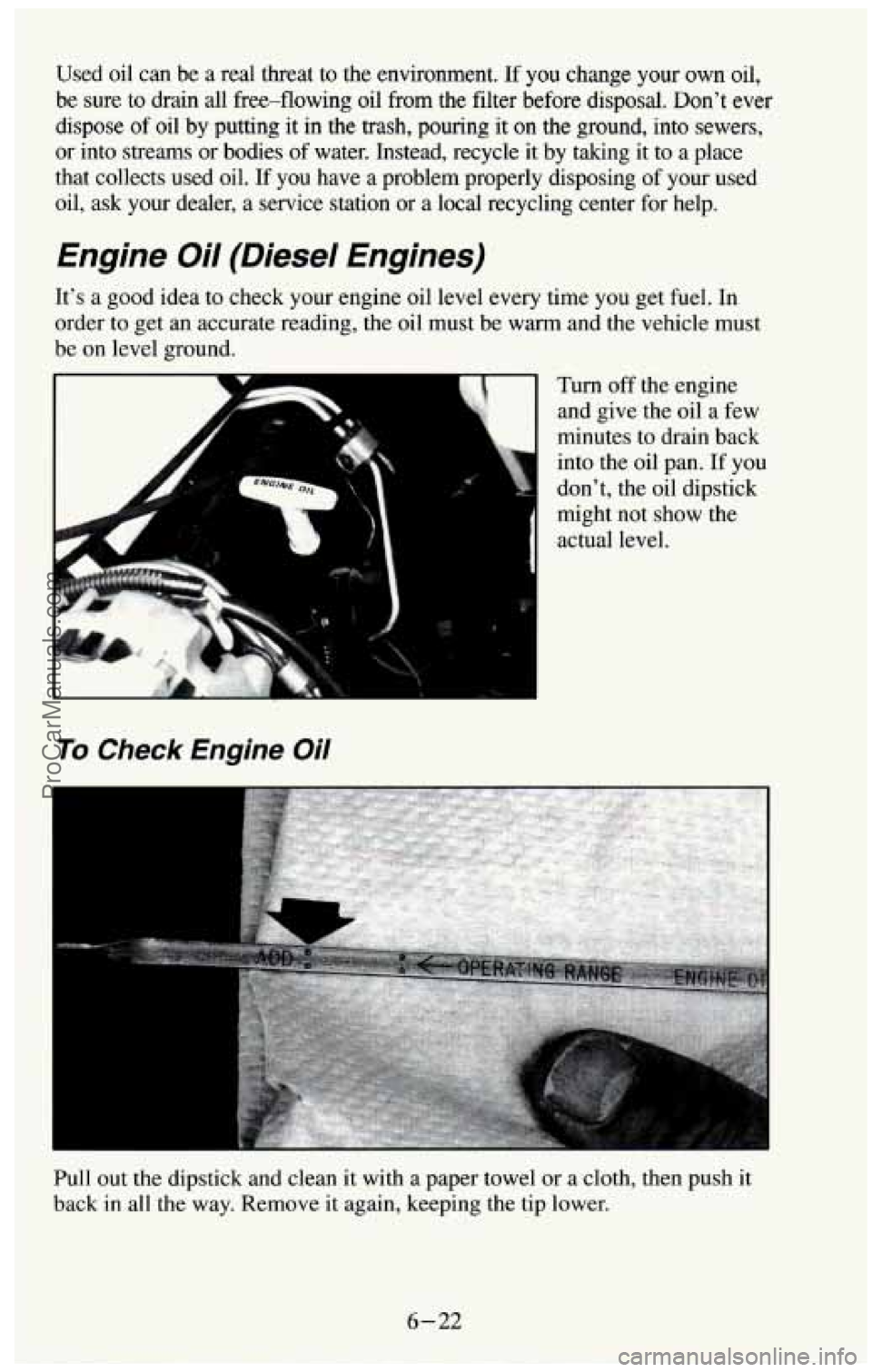
Used oil can be a real threat to the environment. If you change your own oil,
be sure to drain all free-flowing oil from the filter before disposal. Don't ever
dispose of oil by putting it in the trash, pouring it on the ground, into sewers,
or into streams or bodies of water. Instead, recycle it by taking it to a place
that collects used oil. If you have a problem properly disposing of your used
oil, ask your dealer, a service station or a local recycling center for help.
Engine Oil (Diesel Engines)
It's a good idea to check your engine oil level every time you get fuel. In
order to get an accurate reading, the oil must be warm and the vehicle must
be on level ground.
A
Turn off the engine
and give the oil a few
minutes to drain back
into the oil pan. If you
don't, the oil dipstick
might not show the
actual level.
To Check Engine Oil
Pull out the dipstick and clean it with a paper towel or a cloth, then push it
back
in all the way. Remove it again, keeping the tip lower.
6-22
ProCarManuals.com
Page 327 of 385
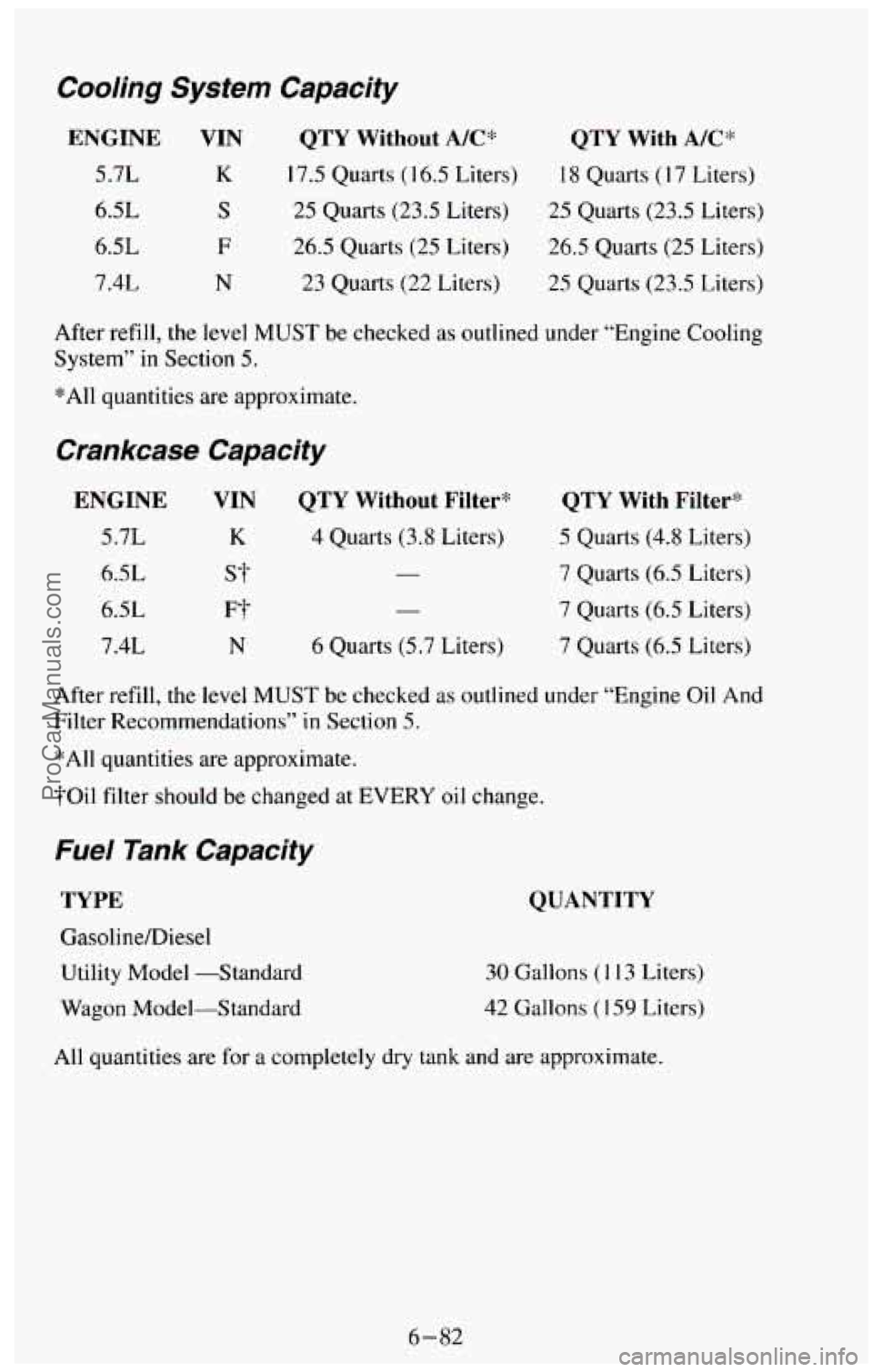
Cooling System Capacity
ENGINE VIN
5.7L K
6.5L S
6.5L F
7.4L N
QTY Without AfC* QTY With A/C*
17.5 Quarts (1 6.5 Liters)
18 Quarts ( I7 Liters)
25 Quarts
(23.5 Liters) 25 Quarts (23.5 Liters)
26.5 Quarts (25 Liters)
26.5 Quarts (25 Liters)
23 Quarts (22 Liters)
25 Quarts (23.5 Liters)
After refill, the level MUST be checked as outlined under “Engine Cooling
System”
in Section 5.
*All quantities are approximate.
Crankcase Capacity
ENGINE
5.7L
6.5L
6.5L
7.4L
VIN
K
ST
F?
N
QTY Without Filter“
4 Quarts (3.8 Liters)
6 Quarts (5.7 Liters)
QTY With Filter:$
5 Quarts (4.8 Liters)
7 Quarts (6.5 Liters)
7 Quarts
(6.5 Liters)
7 Quarts (6.5 Liters)
After refill, the level MUST be checked
as outlined under “Engine Oil And
Filter Recommendations”
in Section 5.
*All quantities are approximate.
?Oil filter should be changed at
EVERY oil change.
Fuel Tank Capacity
TYPE
Gasoline/Diesel
Utility Model -Standard
Wagon Model-S tandard
QUANTITY
30 Gallons (I 13 Liters)
42 Gallons (I 59 Liters)
All quantities are for a completely dry tank and are approximate.
6-82
ProCarManuals.com